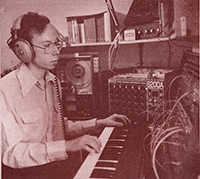Editor’s Note: The biggest challenge in producing the New Dreamers has been defining the type of music that is played on the program. Producer Peter Nothnagle says, “To define is to set a boundary, and the music of the New Dreamers cries out against the boundaries set by traditional music composition.” Thus, rather than defining the music in this article, Peter describes the sources and some of the processes which he and other “new dreamers” use to create their music.
The Electronic music synthesizer is a somewhat heartless collection of solid-state circuits controlled from an all-to imposing looking panel of knobs and switches. The design and function of these circuits are controlled by the strict laws of physics, but when the endless varieties and combinations of sound the synthesizer can produce are explored by a musician, the result can be a beautiful music new to one’s ears.
Although the variety of sounds that the synthesizer can produce is vast, it make a poor musical instrument, because the control of tone, color, articulation, and loudness that are possible on the simplest acoustic instrument is clumsy, if not impossible, on the most advanced synthesizer. The synthesist overcomes this limitation in three ways: other machines can be used to control the synthesizer, devices that can change settings faster and more accurately than human hands. Second, with the resources of the modern recording studio, sounds can be changed once they are recorded, and many sounds can be “layered” on tape to give the fullness of many instruments played at once. Finally, acoustic instruments can be played to electronic accompaniment, taking advantage of the capabilities of each.
All of these methods require careful preparation and this, along with the experimental improvisatory nature of the music, makes live performance of electronic music difficult. This leads to an exciting thought: although recordings of every other kind of music are imitations of real performances, a recording of an electronic composition is a true performance. When such a performance is heard on a record or on the radio, it is the composer performing in your home!
The artistic possibility of a composer wielding tremendous sonic resources, yet communicating with each listener in this personal way, began my fascination with electronic music seven years ago. Since then, I have been composing in my studio. In the past year, I have discovering a group of composers of a certain type of
electronic music that has been vaguely described as “commercial” and “popular,” both words conjuring false preconceptions of the way this fine music sounds.
But that brings us back to the problem of defining the music of the new electronic music composers, and the best way I can communicate the essence of their music is to play it for you.


